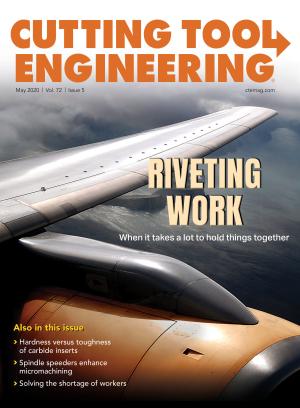Have you recently tried to hire a machinist, a welder, an electrician or any other type of craftsperson? If so, you likely believe that it is harder than ever. Metalworking professionals are in a difficult situation, and it does not take a Nobel Prize-winning economist to recognize that this is a classic Keynesian problem of supply and demand.
Multiple media outlets and government sources would have us believe that these circumstances are a result of record-low unemployment and older workers leaving the market. However, positive economic conditions — depending on how the coronavirus continues to play out in the months ahead — and retiring baby boomers simply have exacerbated a situation that has existed for a long time. The industry just is not creating an adequate number of personnel to support the need.
Demand for craftsmen and craftswomen is high. Countless openings for toolmakers, machinists and every other type of craft are listed on job boards. Talk to any manufacturing operations leader, and he or she will confirm the demand. Listen to news reports, and you will hear small-business owners discuss limiting business expansion because they do not have access to enough skilled labor. The problem threatens the economy and industrial machine that made the United States the wealthiest country in the world.
Finding Solutions
So how do manufacturers fix the problem?
First, they need to strengthen vocational education programs beginning in high schools. Having high-quality equipment and well-developed classrooms that represent real-life manufacturing is important, and industry should push government leaders to adequately fund the programs. Also, business leaders must commit resources to support vocational education in communities and encourage government representatives to appropriate funding.

Apprenticeships are the most traditional way for young people to gain work-related knowledge outside a classroom, but too few of these programs are offered to supply the number of needed workers.
Money for high school vocational programs is valuable, but it does no good to have well-funded but poorly attended programs. Schools and businesses must start to promote the benefits of an effective vocational education and well-developed skills. Students should visit advanced manufacturing facilities, talk to employees and be given an opportunity to experience industrial elements like machining, automation, pneumatics, hydraulics and electronics. Essentially, students need to be allowed to play and experiment with these areas in an educational setting to help develop interest.
High schools currently are not capable of supplying enough skilled workers to the market, so manufacturers rely primarily on programs found at community colleges and postsecondary vocational schools to prepare young people for entry into a skilled trade. As a result, leaders need to aggressively fund these programs. Classrooms must have the same advanced equipment as manufacturing facilities, and lessons should present actual scenarios experienced in factories. Accomplishing these objectives requires an assertive approach to funding and a commitment from business to support the programs.
Promoting and strengthening vocational programs is a shared responsibility. Government is unable to improve the situation alone; vocational programs will flourish only when industry takes the lead. I have heard some business leaders deride local vocational programs about poorly equipped classrooms, low attendance and inadequate curricula. These are the same leaders who do not participate in program development opportunities and never provide feedback to people who determine funding. Vocational programs work when industry provides guidance to educators.
Foundation of Success
To foster important, long-term relationships, communication and guidance between leaders of industry and education are the foundation of success. For a vocational program to succeed, students and instructors must be able to experience actual manufacturing environments.
Apprenticeships are the most traditional way for young people to gain work-related knowledge outside a classroom, but too few of these programs are offered to supply the number of needed workers. Industry must become more aggressive and creative in approaching training programs. The best vocational programs will not create craftspeople prepared to add value unless industry provides opportunities for students to learn.
Apprenticeships, co-op programs and internships developed with vocational schools are the most effective, efficient ways to train future employees. At Mitsubishi Hitachi Power Systems Americas Inc., we have been extremely successful with our internship program. We work with local vocational schools to recruit welding and machining students as interns.
While completing academic requirements, interns are assigned to work with our most skilled craftspeople. Interns study theory and get the opportunity to apply what they learn. Benefits are numerous. Students are paid to experience a real production environment. They learn company methods and culture without the pressures of production. When they become full-time employees — we have a 100% retention rate — they are often more productive than people new to our culture and methods. We pay the tuition, and interns frequently receive academic credit for time spent at our shop. Interns are also our best recruiters because they connect us to other students and craftspeople who fit well with our culture.
Industry-led training and vocational programs are the only viable solution to the shortage of personnel. The business sector must provide guidance and leadership to people in education and government to build strong vocational programs. Industry, not the educational system, needs to be on the front lines generating interest and drawing young people into trades. Manufacturers should work with educators to create effective curricula and should open shops to students so they can get real-life training. To succeed, we in industry must lead students, educators and government representatives through our direct involvement.
Related Glossary Terms
- metalworking
metalworking
Any manufacturing process in which metal is processed or machined such that the workpiece is given a new shape. Broadly defined, the term includes processes such as design and layout, heat-treating, material handling and inspection.


